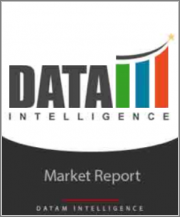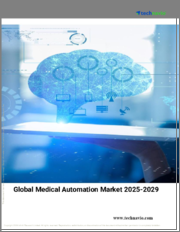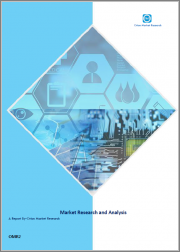
|
시장보고서
상품코드
1290437
세계의 의료용 자동화 기술 시장(2023-2030년)Global Medical Automation Technology Market - 2023-2030 |
||||||
시장 개요
세계의 의료용 자동화 기술 시장은 2022년 436억 달러에 달하며, 2030년에는 최대 900억 달러에 달할 것으로 예상됩니다. 의료용 자동화 기술 시장은 2023-2030년의 예측 기간 중 9.8%의 CAGR을 보일 것으로 예상됩니다.
의료용 자동화 기술 시장은 최근 몇 년동안 헬스케어 분야에서 크게 성장하고 있습니다. 이 기술을 통해 많은 의료 업무가 로봇, 인공지능(AI), 머신러닝과 같은 자동화 시스템을 통해 이루어지고 있습니다.
의료용 자동화 기술 덕분에 의료 서비스를 보다 효과적이고 효율적으로 제공할 수 있습니다. 의료용 자동화 기술은 환자 결과 개선, 생산성 향상, 비용 절감을 통해 의료 부문을 변화시킬 수 있는 잠재력을 가지고 있습니다.
시장 역학
의료 자동화 투자 증가로 시장 확대 가속화
의료 자동화 투자는 세계 의료용 자동화 기술의 기회를 증가시킬 것으로 예상됩니다. 예를 들어 2022년 7월, Health Note는 SignalFire가 주도한 1,700만 달러 규모의 시리즈 A 펀딩 라운드를 마감했습니다. 이 방문 전 임상 섭취 자동화 플랫폼은 디지털 환자 섭취를 채택하여 환자 예약 전에 의사를 위한 임상 노트를 작성합니다.
UnityPoint Health, Northwell Holdings, Cedars Sinai Health Ventures, Northwell Health는 시그널파이어의 파트너사 중 하나입니다. 노스웰 헬스(Northwell Health)의 영리 부문으로, 초기 단계/성장 기회에 대한 투자, 전략적 파트너십, 환자 치료 개선을 촉진하고 의료 시스템의 다양한 수입원을 창출하는 내부 혁신을 육성하는 데 중점을 두고 있습니다.
그리고 2022년 11월, 의료 영상 주석 서비스 시장을 확대하기 위해 의료 기술 기업 RedBrick AI는 Sequoia India와 동남아시아의 Surge가 주도하는 자금 조달 라운드에서 460만 달러를 조달했습니다.
고가의 자동화 장비와 숙련된 전문가 부족이 시장 성장을 저해하고 있습니다.
높은 자동화 장비 비용, 숙련된 인력 부족, 기업이 제품 및 서비스를 도입하는 데 필요한 긴 규제 절차, 정부가 의료기기 제조 기업에 부과하는 세금 등이 시장 확대에 걸림돌이 될 것으로 예상됩니다.
COVID-19의 영향 분석
의료용 자동화 기술 시장은 COVID-19로 인해 잠재적인 기회를 맞이하고 있습니다. 예를 들어 COVID-19는 의료 중단을 최소화하고 의료 서비스 접근성을 줄이기 위해 가상 의료 개입이 시급히 필요하다는 것을 보여주고 있습니다.
예를 들어 Harward Global Health Institute는 COVID-19 예측 모델 앱을 만들어 환자 발생, 입원, 중환자실 입실, 인공호흡기 사용, 사망에 대한 사전 경고 시스템을 제공했습니다. 이 앱 덕분에 의료진들이 선제적으로 대응하고 전염병을 막을 수 있었습니다. 그렇기 때문에 의료 산업에서 더 많은 자동화 기술이 개발되는 것은 매우 고무적인 일입니다.
러시아·우크라이나 전쟁의 영향 분석
러시아·우크라이나는 이 지역의 낮은 보급률과 주요 시장 참여자가 없기 때문에 세계 의료용 자동화 기술 시장에 미치는 영향은 미미할 것으로 추정됩니다. 그러나 원자재, 테스트 제품 및 장비의 수입 및 수출의 영향은 예측 기간 중 세계 의료용 자동화 기술 시장에 거의 영향을 미치지 않을 것으로 예상됩니다.
인공지능(AI)의 영향력 분석
인공지능은 전자건강기록(EHR)의 환자 데이터를 분석하여 인간 의료진이 즉각적으로 볼 수 없는 패턴과 인사이트을 찾아내어 보다 정확한 진단과 성공적인 치료를 가능하게 함으로써 세계 의료용 자동화 기술 시장에 긍정적인 영향을 미칠 것으로 예상됩니다.
목차
제1장 조사 방법과 범위
- 조사 방법
- 조사 목적 및 조사 범위
제2장 정의와 개요
제3장 주요 요약
제4장 시장 역학
- 영향요인
- 촉진요인
- 의료 자동화의 투자 증가는 시장 성장을 촉진
- 증가하는 애플리케이션과 제공되는 이점
- 억제요인
- 자동화 기기의 고비용과 숙련 전문가의 부족이 시장을 방해하고 있다.
- 기회
- 만성질환의 증가별 확대
- 영향 분석
- 촉진요인
제5장 산업 분석
- Porter's Five Forces 분석
- 공급망 분석
- 미충족 요구
- 법규제 분석
제6장 COVID-19의 분석
제7장 러시아·우크라이나 전쟁 분석
제8장 인공지능의 영향 분석
제9장 자동화 건강 평가·모니터링별
- 자동화 홈모니터링과 텔레메트리
- 텔레헬스 키오스크
- 자동 안과 검사 기기
- 자동 약물 검사
- 기타
제10장 자동 영상 처리·영상 분석 분야
- 자동 X선촬영·형광 투시 장비
- 전흉부 초음파 진단 장비
- 컴퓨터 지원 탐지
- 자동 현미경검사
- 피부암 자동 탐지
- 기타
제11장 처방전 자동 제제·조제 자동화 분야
- 포장기
- 정맥주사용 컴파운더
- 기타
제12장 치료(비외과) 시술 자동화 분야
- 자동 제세동기
- 자동 메디케이션 딜리버리 시스템
제13장 의료용 로봇·컴퓨터 지원 수술 기기별
- 수술 플래너·시뮬레이터
- 서지컬 내비게이션 시스템
- 수술용 로봇
- 지능형 수술실과 관련 장비
제14장 임상 검사·분석 자동화 분야별
- 중앙 검사실 시스템
- POC(Point-Of-Care) 검사 시스템
제15장 최종사용자별
- 병원
- 외래 수술 센터
- 기타
제16장 지역별
- 북미
- 미국
- 캐나다
- 멕시코
- 유럽
- 독일
- 영국
- 프랑스
- 이탈리아
- 스페인
- 기타 유럽
- 남미
- 브라질
- 아르헨티나
- 기타 남미 지역
- 아시아태평양
- 중국
- 인도
- 일본
- 호주
- 기타 아시아태평양
- 중동 및 아프리카
제17장 경쟁 구도
- 경쟁 시나리오
- 시장 점유율 분석
- M&A(합병·인수) 분석
제18장 기업 개요
- Siemens AG
- 회사 개요
- 제품 포트폴리오와 설명
- 재무 개요
- 주요 발전 상황
- Accuray Incorporated
- Kahle automation
- Muratec, Ltd.
- Schneeberger
- Hitachi
- Danaher Corporation
- Becton, Dickinson and Company
- Stanley Black and Decker Inc.
- Intuitive Surgical.
제19장 부록
KSA 23.06.29Market Overview
The Global Medical Automation Technology Market reached US$ 43.6 billion in 2022 and is projected to witness lucrative growth by reaching up to US$ 90 billion by 2030. The Global Medical Automation Technology Market is expected to exhibit a CAGR of 9.8% during the forecast period 2023-2030.
The medical automation technology market has grown significantly within the healthcare sector in recent years. With this technology, many medical duties are carried out by automated systems, including robots, artificial intelligence (AI), and machine learning.
Healthcare delivery can become more effective and efficient thanks to medical automation technology. The potential for medical automation technologies to transform the healthcare sector by enhancing patient outcomes, boosting productivity, and lowering costs.
MarketDynamics
Medical Automation Investments that are Increased Will Accelerate Market Expansion.
Medical automation investments are expected to increase global medical automation technology opportunities. For instance, in July 2022, the US$17 million Series A fundraising round led by SignalFire was closed by Health Note. This pre-visit clinical intake automation platform employs digital patient intake to produce clinical notes for physicians ahead of patient appointments.
UnityPoint Health, Northwell Holdings, Cedars Sinai Health Ventures, and Northwell Health are all partners in SignalFire. Northwell Holdings is the for-profit division of Northwell Health that focuses on investments in early-stage/growth opportunities, strategic partnerships, and the cultivation of internal innovations that drive improvements in patient care and create diversified revenue streams for the health system.
And in November 2022, to extend the market for its medical image annotations service, health tech firm RedBrick AI raised $4.6 million in a fundraising round led by Sequoia India and Southeast Asia's Surge.
The High Cost of Automation Equipment and Lack of Skilled Professionals are Hampering the Market Growth.
The high cost of automation equipment, the scarcity of trained workers, the lengthy regulatory processes required by businesses to introduce a product or service, and the tax placed by the government on enterprises that make medical devices are expected to impede market expansion.
COVID-19 Impact Analysis
The medical automation technology market has potential opportunities due to COVID-19. For instance, COVID-19 has shown that virtual care interventions are urgently needed to minimize interruptions and reduce access to healthcare.
For instance, the Harward Global Health Institute created an app for the COVID-19 forecasting model that provided a prior warning system for cases, hospitalizations, ICU admissions, ventilator usage, and deaths. This app allowed healthcare professionals to be proactive and stop the pandemic, which is why it is so encouraging to see the development of more automation technology in the medical industry.
Russia-Ukraine War Impact Analysis
The Russia-Ukraine is estimated to have a minimal impact on the global medical automation technology market owing to the low prevalence and absence of key market players in this region. However, the impact of the import and export of raw materials, test products, and devices is anticipated to have little influence over the global Medical Automation Technology market in the forecast period.
Artificial Intelligence Impact Analysis
Artificial intelligence is anticipated to positively impact the Global Medical Automation Technology Market because AI can analyze patient data in electronic health records (EHRs) to find patterns and insights that human healthcare practitioners might not instantly see, resulting in more precise diagnoses and more successful treatments.
Segment Analysis
The Global Medical Automation Technology Market is segmented based on automated health assessment and monitoring by automated imaging and image analysis, automated prescription formulation and dispensing, automated therapeutic (nonsurgical) procedures, medical robotics, and computer-assisted surgical devices, by automated laboratory testing and analysis, by end-user, and region.
Surgical Robots is Estimated to Hold a Majority 0f the Medical Automation Technology Market Share During the Forecast Period.
The surgical robots' medical robotics and computer-assisted surgical devices hold about 46.3% of the total medical automation technology market. The segment will rise more rapidly due to the increasing clinical requirement for surgical procedures brought on by the increased prevalence of chronic illnesses and malignancies.
Additionally, rising healthcare costs in emerging nations, new product breakthroughs, and favorable reimbursement environments in a few countries will all contribute to the segment's growth.
For instance, in January 2021, the SSI multi-arm revolutionary telerobotic assistance surgical system was made available in the nation by the medical robotic technology company SS Innovations for a cost of Rs 4-5 crore. The company claimed in a statement that the restricted availability of the dominant contemporary robotic technology is due to its high cost and difficult learning curve.
Geographical Analysis
North America is Estimated to Hold the Largest Share of the Global Medical Automation Technology Market During the Forecast Period.
The North American region holds the largest global medical automation technology market share, accounting for approximately 41.2% in the forecast period.
Due to the rapid advancements in information technology and healthcare, North America is one of the markets for medical automation technologies. For instance, the American Hospital Association estimates that in 2021 the U.S. will spend US$4.3 trillion, or US$12,914 per person, on health care. This growth rate is considerably less than the 2020 growth forecast (10.3%).
This significant slowdown in spending can be linked to a drop in government spending on pandemic-related expenses, countering an increase in medical supplies and services that recovered from 2020 owing to delayed care and pent-up demand. In contrast with 2020, when health spending made up 19.7% of GDP, it was 18.3% of GDP in 2021.
Over the forecast period, the global expansion of healthcare automation is driven by the rising acceptance rate of high-tech medical equipment and healthcare reimbursement system.
Competitive Landscape
The major global players in the market include: Siemens AG, Accuray Incorporated, Kahle automation, Muratec, Ltd., Schneeberger, Hitachi, Danaher Corporation, Becton Dickinson and Company, Stanley Black and Decker Inc, Intuitive Surgical, among others.
Why Purchase the Report?
- To visualize the Global Medical Automation Technology Market segmentation based on product, application, and region and understand critical commercial assets and players.
- Identify commercial opportunities by analyzing trends and co-development.
- Excel data sheet with numerous medical automation technology market-level data points with all segments.
- PDF report consists of a comprehensive analysis after exhaustive qualitative interviews and an in-depth study.
- Product mapping available as Excel consisting of key products of all the major players.
The Global Medical Automation Technology Market Report Would Provide Approximately 53 Tables,54 Figures And 195 pages.
Target Audience 2023
- Manufacturers/ Buyers
- Industry Investors/Investment Bankers
- Research Professionals
- Emerging Companies
Table of Contents
1. Methodology and Scope
- 1.1. Research Methodology
- 1.2. Research Objective and Scope of the Report
2. Definition and Overview
3. Executive Summary
- 3.1. Snippet by Automated Health Assessment and Monitoring
- 3.2. Snippet by Automated Imaging And Image Analysis
- 3.3. Snippet by Automated Prescription Formulation and Dispensing
- 3.4. Snippet by Automated Therapeutic (Nonsurgical) Procedures
- 3.5. Snippet by Medical Robotics and Computer-Assisted Surgical Devices
- 3.6. Snippet by Automated Laboratory Testing and Analysis
- 3.7. Snippet by End User
- 3.8. Snippet by Region
4. Dynamics
- 4.1. Impacting Factors
- 4.1.1. Drivers
- 4.1.1.1. Increasing investment of medical automation can surge the market growth
- 4.1.1.2. The Increasing Application and Benefits Offered
- 4.1.2. Restraints
- 4.1.2.1. The high cost of automation equipment and lack of skilled professionals are hampering the market
- 4.1.3. Opportunity
- 4.1.3.1. Expanding due to an increase in chronic diseases
- 4.1.4. Impact Analysis
- 4.1.1. Drivers
5. Industry Analysis
- 5.1. Porter's 5 Forces Analysis
- 5.2. Supply Chain Analysis
- 5.3. Unmet Needs
- 5.4. Regulatory Analysis
6. COVID-19 Analysis
- 6.1. Analysis of COVID-19
- 6.1.1. Scenario Before COVID-19
- 6.1.2. Scenario During COVID-19
- 6.1.3. Post COVID-19 & Future Scenario
- 6.2. Pricing Dynamics Amid COVID-19
- 6.3. Government Initiatives Related to the Market During the Pandemic
- 6.4. Manufacturers' Strategic Initiatives
- 6.5. Conclusion
7. Russia-Ukraine War Analysis
8. Artificial Intelligence Impact Analysis
9. By Automated Health Assessment and Monitoring
- 9.1. Introduction
- 9.1.1. Market Size Analysis and Y-o-Y Growth Analysis (%), By Automated Health Assessment and Monitoring
- 9.1.2. Market Attractiveness Index, By Automated Health Assessment and Monitoring
- 9.2. Automated Home Monitoring and Telemetry
- 9.2.1. Introduction
- 9.2.2. Market Size Analysis and Y-o-Y Growth Analysis (%)
- 9.3. Telehealth Kiosks
- 9.4. Automated Eye Examination Devices
- 9.5. Automated Drug Testing
- 9.6. Others
10. By Automated Imaging and Image Analysis
- 10.1. Introduction
- 10.1.1. Market Size Analysis and Y-o-Y Growth Analysis (%), By Automated Imaging And Image Analysis
- 10.1.2. Market Attractiveness Index, By Automated Imaging And Image Analysis
- 10.2. Automated Radiography and Fluoroscopy
- 10.2.1. Introduction
- 10.2.2. Market Size Analysis and Y-o-Y Growth Analysis (%)
- 10.3. Automated Whole-Breast Ultrasound
- 10.4. Computer-Aided Detection
- 10.5. Automated Microscopy
- 10.6. Automated Skin Cancer Detection
- 10.7. Others
11. By Automated Prescription Formulation and Dispensing
- 11.1. Introduction
- 11.1.1. Market Size Analysis and Y-o-Y Growth Analysis (%), By Automated Prescription Formulation and Dispensing
- 11.1.2. Market Attractiveness Index, By Automated Prescription Formulation and Dispensing
- 11.2. Packaging Machines
- 11.2.1. Introduction
- 11.2.2. Market Size Analysis and Y-o-Y Growth Analysis (%)
- 11.3. Intravenous Compounders
- 11.4. Others
12. By Automated Therapeutic (Nonsurgical) Procedures
- 12.1. Introduction
- 12.1.1. Market Size Analysis and Y-o-Y Growth Analysis (%), By Automated Therapeutic (Nonsurgical) Procedures
- 12.1.2. Market Attractiveness Index, By Automated Therapeutic (Nonsurgical) Procedures
- 12.2. Automated Defibrillators
- 12.2.1. Introduction
- 12.2.2. Market Size Analysis and Y-o-Y Growth Analysis (%)
- 12.3. Automated Medication Delivery Systems
13. By Medical Robotics and Computer-Assisted Surgical Devices
- 13.1. Introduction
- 13.1.1. Market Size Analysis and Y-o-Y Growth Analysis (%), By Medical Robotics and Computer-Assisted Surgical Devices
- 13.1.2. Market Attractiveness Index, By Medical Robotics and Computer-Assisted Surgical Devices
- 13.2. Surgical Planners and Simulators
- 13.2.1. Introduction
- 13.2.2. Market Size Analysis and Y-o-Y Growth Analysis (%)
- 13.3. Surgical Navigation Systems
- 13.4. Surgical Robots
- 13.5. Intelligent Operating Rooms and Related Equipment
14. By Automated Laboratory Testing and Analysis
- 14.1. Introduction
- 14.1.1. Market Size Analysis and Y-o-Y Growth Analysis (%), By Automated Laboratory Testing and Analysis
- 14.1.2. Market Attractiveness Index, By Automated Laboratory Testing and Analysis
- 14.2. Central Laboratory Systems
- 14.2.1. Introduction
- 14.2.2. Market Size Analysis and Y-o-Y Growth Analysis (%)
- 14.3. Point-Of-Care Testing Systems
15. By End User
- 15.1. Introduction
- 15.1.1. Market Size Analysis and Y-o-Y Growth Analysis (%), By End User
- 15.1.2. Market Attractiveness Index, By End User
- 15.2. Hospitals
- 15.2.1. Introduction
- 15.2.2. Market Size Analysis and Y-o-Y Growth Analysis (%)
- 15.3. Ambulatory Surgical Centers
- 15.4. Other
16. By Region
- 16.1. Introduction
- 16.1.1. Market Size Analysis and Y-o-Y Growth Analysis (%), By Region
- 16.1.2. Market Attractiveness Index, By Region
- 16.2. North America
- 16.2.1. Introduction
- 16.2.2. Key Region-Specific Dynamics
- 16.2.3. Market Size Analysis and Y-o-Y Growth Analysis (%), By Automated Health Assessment and Monitoring
- 16.2.4. Market Size Analysis and Y-o-Y Growth Analysis (%), By Automated Imaging And Image Analysis
- 16.2.5. Market Size Analysis and Y-o-Y Growth Analysis (%), By Automated Prescription Formulation and Dispensing
- 16.2.6. Market Size Analysis and Y-o-Y Growth Analysis (%), By Automated Therapeutic (Nonsurgical) Procedures
- 16.2.7. Market Size Analysis and Y-o-Y Growth Analysis (%), By Medical Robotics and Computer-Assisted Surgical Devices
- 16.2.8. Market Size Analysis and Y-o-Y Growth Analysis (%), By Automated Laboratory Testing and Analysis
- 16.2.9. Market Size Analysis and Y-o-Y Growth Analysis (%), By End User
- 16.2.10. Market Size Analysis and Y-o-Y Growth Analysis (%), By Country
- 16.2.10.1. The U.S.
- 16.2.10.2. Canada
- 16.2.10.3. Mexico
- 16.3. Europe
- 16.3.1. Introduction
- 16.3.2. Key Region-Specific Dynamics
- 16.3.3. Market Size Analysis and Y-o-Y Growth Analysis (%), By Automated Health Assessment and Monitoring
- 16.3.4. Market Size Analysis and Y-o-Y Growth Analysis (%), By Automated Imaging And Image Analysis
- 16.3.5. Market Size Analysis and Y-o-Y Growth Analysis (%), By Automated Prescription Formulation and Dispensing
- 16.3.6. Market Size Analysis and Y-o-Y Growth Analysis (%), By Automated Therapeutic (Nonsurgical) Procedures
- 16.3.7. Market Size Analysis and Y-o-Y Growth Analysis (%), By Medical Robotics and Computer-Assisted Surgical Devices
- 16.3.8. Market Size Analysis and Y-o-Y Growth Analysis (%), By Automated Laboratory Testing and Analysis
- 16.3.9. Market Size Analysis and Y-o-Y Growth Analysis (%), By End User
- 16.3.10. Market Size Analysis and Y-o-Y Growth Analysis (%), By Country
- 16.3.10.1. Germany
- 16.3.10.2. The U.K.
- 16.3.10.3. France
- 16.3.10.4. Italy
- 16.3.10.5. Spain
- 16.3.10.6. Rest of Europe
- 16.4. South America
- 16.4.1. Introduction
- 16.4.2. Key Region-Specific Dynamics
- 16.4.3. Market Size Analysis and Y-o-Y Growth Analysis (%), By Automated Health Assessment and Monitoring
- 16.4.4. Market Size Analysis and Y-o-Y Growth Analysis (%), By Automated Imaging And Image Analysis
- 16.4.5. Market Size Analysis and Y-o-Y Growth Analysis (%), By Automated Prescription Formulation and Dispensing
- 16.4.6. Market Size Analysis and Y-o-Y Growth Analysis (%), By Automated Therapeutic (Nonsurgical) Procedures
- 16.4.7. Market Size Analysis and Y-o-Y Growth Analysis (%), By Medical Robotics and Computer-Assisted Surgical Devices
- 16.4.8. Market Size Analysis and Y-o-Y Growth Analysis (%), By Automated Laboratory Testing and Analysis
- 16.4.9. Market Size Analysis and Y-o-Y Growth Analysis (%), By End User
- 16.4.10. Market Size Analysis and Y-o-Y Growth Analysis (%), By Country
- 16.4.10.1. Brazil
- 16.4.10.2. Argentina
- 16.4.10.3. Rest of South America
- 16.5. Asia-Pacific
- 16.5.1. Introduction
- 16.5.2. Key Region-Specific Dynamics
- 16.5.3. Market Size Analysis and Y-o-Y Growth Analysis (%), By Automated Health Assessment and Monitoring
- 16.5.4. Market Size Analysis and Y-o-Y Growth Analysis (%), By Automated Imaging And Image Analysis
- 16.5.5. Market Size Analysis and Y-o-Y Growth Analysis (%), By Automated Prescription Formulation and Dispensing
- 16.5.6. Market Size Analysis and Y-o-Y Growth Analysis (%), By Automated Therapeutic (Nonsurgical) Procedures
- 16.5.7. Market Size Analysis and Y-o-Y Growth Analysis (%), By Medical Robotics and Computer-Assisted Surgical Devices
- 16.5.8. Market Size Analysis and Y-o-Y Growth Analysis (%), By Automated Laboratory Testing and Analysis
- 16.5.9. Market Size Analysis and Y-o-Y Growth Analysis (%), By End User
- 16.5.10. Market Size Analysis and Y-o-Y Growth Analysis (%), By Country
- 16.5.10.1. China
- 16.5.10.2. India
- 16.5.10.3. Japan
- 16.5.10.4. Australia
- 16.5.10.5. Rest of Asia-Pacific
- 16.6. Middle East and Africa
- 16.6.1. Introduction
- 16.6.2. Key Region-Specific Dynamics
- 16.6.3. Market Size Analysis and Y-o-Y Growth Analysis (%), By Automated Health Assessment and Monitoring
- 16.6.4. Market Size Analysis and Y-o-Y Growth Analysis (%), By Automated Imaging And Image Analysis
- 16.6.5. Market Size Analysis and Y-o-Y Growth Analysis (%), By Automated Prescription Formulation and Dispensing
- 16.6.6. Market Size Analysis and Y-o-Y Growth Analysis (%), By Automated Therapeutic (Nonsurgical) Procedures
- 16.6.7. Market Size Analysis and Y-o-Y Growth Analysis (%), By Medical Robotics and Computer-Assisted Surgical Devices
- 16.6.8. Market Size Analysis and Y-o-Y Growth Analysis (%), By Automated Laboratory Testing and Analysis
- 16.6.9. Market Size Analysis and Y-o-Y Growth Analysis (%), By End User
17. Competitive Landscape
- 17.1. Competitive Scenario
- 17.2. Market Share Analysis
- 17.3. Mergers and Acquisitions Analysis
18. Company Profiles
- 18.1. Siemens AG
- 18.1.1. Company Overview
- 18.1.2. Product Portfolio and Description
- 18.1.3. Financial Overview
- 18.1.4. Key Developments
- 18.2. Accuray Incorporated
- 18.3. Kahle automation
- 18.4. Muratec, Ltd.
- 18.5. Schneeberger
- 18.6. Hitachi
- 18.7. Danaher Corporation
- 18.8. Becton, Dickinson and Company
- 18.9. Stanley Black and Decker Inc.
- 18.10. Intuitive Surgical.
LIST NOT EXHAUSTIVE
19. Appendix
- 19.1. About Us and Services
- 19.2. Contact Us


















